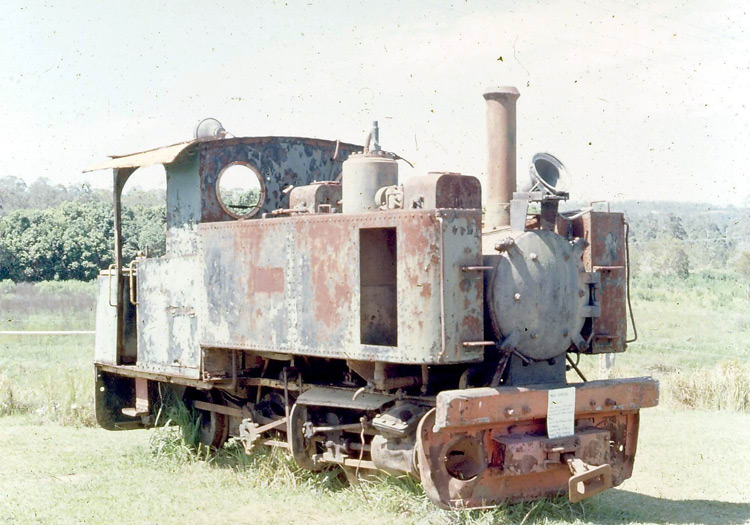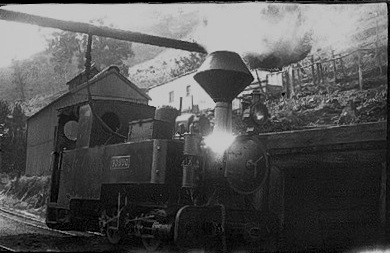|
This
locomotive was built new for the NSW Department of Public Works, one of
four Krauss built locos working on the Burrinjuck Dam project. The four
Krauss locomotives featured prominent diamond-stack chimneys and carried
handsome brass nameplates on their side tanks. The Goondah - Burrinjuck
Railway was a lengthy route with steep gradients, built to ferry
construction supplies to the Burrinjuck Dam site on the Murrumbidgee River,
and interfacing with the NSW Main Southern Railway at Goondah, south of
Yass. A sand tramway also feed the cement works near the dam face, which
was worked by a Fowler 0-6-0T ‘Kate’. The five steam locomotives at
Burrinjuck Dam were:
|
Name
|
Builder
|
Notes &
Disposal
|
|
Dulce
|
Krauss b/n 5869 of 1907
|
Became North Eton Mill No.5.
Rebuilt to 0-6-0T in 1937.
|
|
Robin
|
Krauss b/n 5870 of 1907
|
To NSW State Metal Quarries,
Kiama in 1932.
Thought to have been buried at
Pike’s Hill Quarry.
|
|
Archie
|
Krauss b/n 5945 of 1907
|
To Fairymead Mill, Bundaberg
in 1929.
Became No.7. Preserved at
Burrinjuck Dam.
|
|
Jack
|
Krauss b/n 6063 of 1908
|
To Farleigh Mill, Mackay in
1929.
Preserved at Lake Macquarie
Light Railway.
|
|
Kate
|
Fowler b/n 8762 of 1901
|
Worked the sand tramway along
the Murrumbidgee River.
Disposal unknown.
|
The
Goondah - Burrinjuck Railway operated for more than 20 years, reflecting
the size and duration of the Burrinjuck Dam project, but had served its
purpose at the dam’s completion in 1928 and the line was lifted in 1929.
‘Dulce’, ‘Archie’ & ’Jack’ were sold to a Sydney machinery dealer, and
Dulce was on-sold in 1929 to the North Eton Mill, near Mackay, where it
became No.5.
Dulce
underwent a transformation in 1937 when converted from 0-4-0WT to 0-6-0T configuration
by North Eton Mill. The rebuilt locomotive seems to have had an additional
driving axle added to extended main frames, also receiving significantly
larger water tanks, presumably to increase tractive effort and extend
range. The cab rear was also opened out to assist backwards running while
also reducing heat in the cab in the tropical environment of North Eton
Mill.
By 1964
the locomotive was stored at North Eton Mill, presumably replaced in cane
haulage duties by diesel motive power. It was first obtained for
preservation in 1970 but has moved around a bit and not fared well in the
following years. In 1972 it was plinthed at Seal Park, Tanawha, in the
Sunshine Coast Region near Maroochydore. I suspect it suffered the fate of all
such park engines and became a maintenance burden to counter rust and
deterioration. In 1982, Dulce was acquired for private preservation at Kin
Kin, near Gympie. A further change of ownership occurred in 1988 when it
moved to Kallangur to join the growing private collection there. By this
stage I believe the loco had already been dismantled for assessment, but
restoration had stalled and hence ‘Dulce’ arrived at Kallangur as a kit of
parts.
I first
met ‘Dulce’ on 12 April 2003 when the owner kindly showed me around his collection
at Kallangur. I found the loco stored dismantled and rust streaked, with
the frame, cab and tanks being engulfed by the long grass which grows so
quickly in Queensland’s heat and humidity. I didn’t identify the boiler,
but understand it was among those stored on site.
The
industrial premises at Kallangur / Murrumba Downs were sold for
redevelopment around 2007, with North Eton Mill No.5 and most other steam
relics at the site transferred to a new business location at Narangba. Alas
the owner has since passed away and it seems the collection is slowly being
sold, so hopefully ‘Dulce’ will find a benefactor who will oversee its
reassembly and restoration.
An
excellent reference for further reading on this railway and its locomotives
is ‘The Goondah-Burrinjuck Railway’ by John R Newland, published by the
Australian Railway Historical Society, New South Wales Division, 1994. A
second edition was published in 1999.
|


